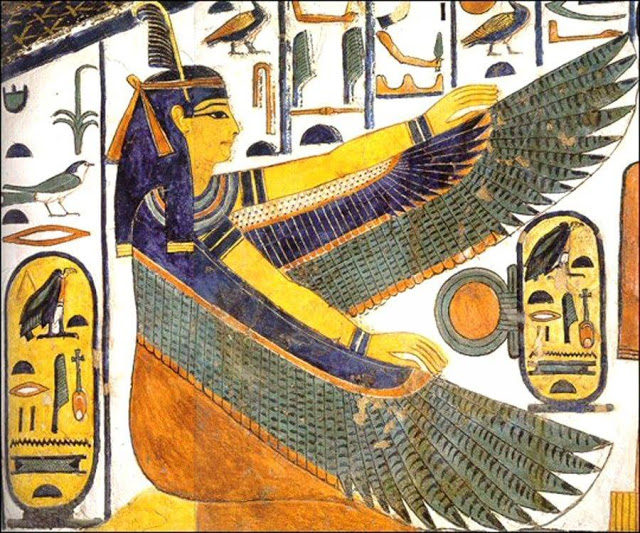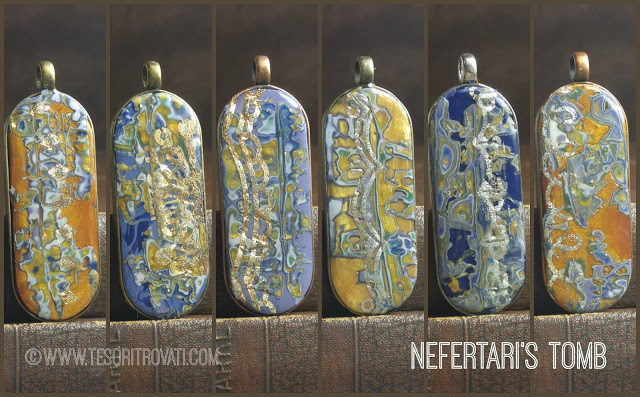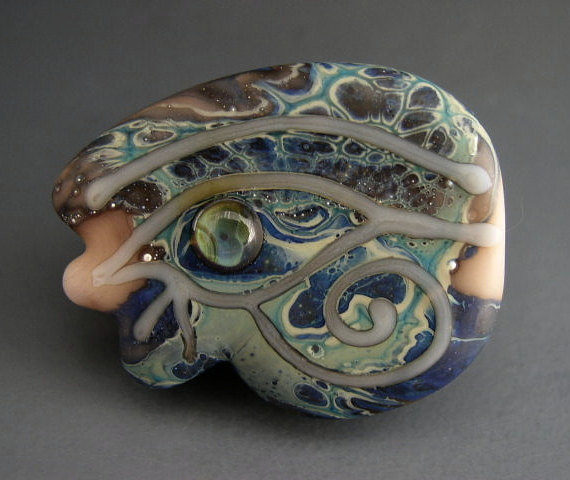Each
week one of our contributors gives you a sneak peek into their studio,
creative process or inspirations. We ask a related question of our
readers and hope you’ll leave comments! As an incentive, we offer a
prize each week to encourage you to use that keyboard and tell us what
you think. The following week a winner is chosen at random from all
eligible entries. And here are the results from last week!
Congratulations Pat Denning!
You have won a cute little pendant from swoondimples!
Contact Heather at swoondimples to claim your prize!
~~~~~~~~~~~~~~~~~~~~~~~~~~~~~~
Today we visit with Erin Prais-Hintz of Tesori Trovati.
Let’s see what treasures she has in store for us…
The ancient tomb of Queen Nefertari is rich with symbolism and color and is a great inspiration for October. This picture of the goddess Ma’at is part of the upper triangular shaped facing walls in the descent into the tomb. Each side of the sloped corridor are near mirror images.
As far as tombs for Queens go, Nefertari’s tomb was extra special. The statues at the opening were made to the same scale as her husband Ramsses II and she was definitely the most highly cherished of all his many wives as evidenced by her style of dress and the titles that she was given. Her tomb is also one of the finest examples of preserved Egyptian art. I was struck in reading about it that it is only available to us in virtual tours, the actual tomb having been restored several times and ultimately closed off. The wall art is spectacular, but the ravages of time (and the moistness of our breath) have irreparably crumbled some of it. Still, the colors were very bright and there was no surface left unadorned.
Since the walls were the most fascinating to me, and they are made from this type of sandstone that has crystal in it that would expand and crumble, I set out to recreate what I thought might be a piece of that crumbling tomb wall.
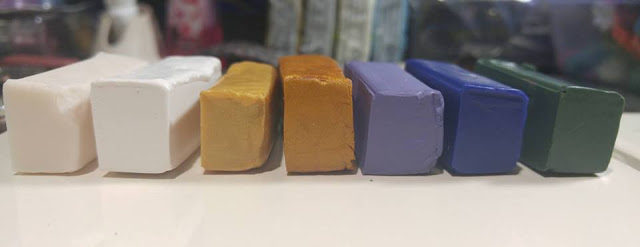
Each month for my
Simple Truths Sampler Club, I come up with a new design based on our art here. I also try to push myself and learn something new. What I decided to teach myself this month was a technique called
‘mokume gane’ (mo-KOO-may GAH-nay). This is actually an ancient Japanese technique for fusing metals and making a sort of moire pattern on decorative objects. It literally means ‘wood grain metal.’ But polymer clay artists are a clever lot, and they have transformed this technique through the great imitative qualities of polymer clay. This technique has always seemed so mysterious to me. I am very attracted to it when I see it. So that meant that I would need to do a little research in order to pull this off. I looked at some online tutorials, but ultimately came back to several books that I have on working with polymer clay, specifically,
The Complete Book of Polymer Clay by Lisa Pavelka. This is a must have book if you are interested in working with polymer clay as so much is explained in great detail.
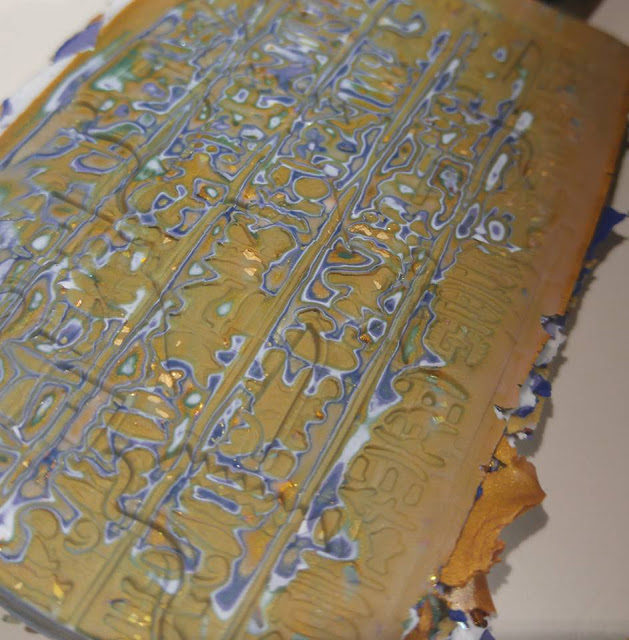
Essentially, thin sheets of clay are melded together, alternating with some translucent clay and thin sheets of metal leaf, distorted in some fashion (like by impressing a stamp into the top) and then slices are shaved off that result in the distinctive patterning. I actually took my colors from the image
palette that Heather generated and used an Egyptian hieroglyphic stamp for the distortion (although it is hard to see the actual imagery).
And it does look a lot like the Fordite that Miss Swoondimples is so in love with! Hmmmm…makes me think of some new applications for expanding this technique!
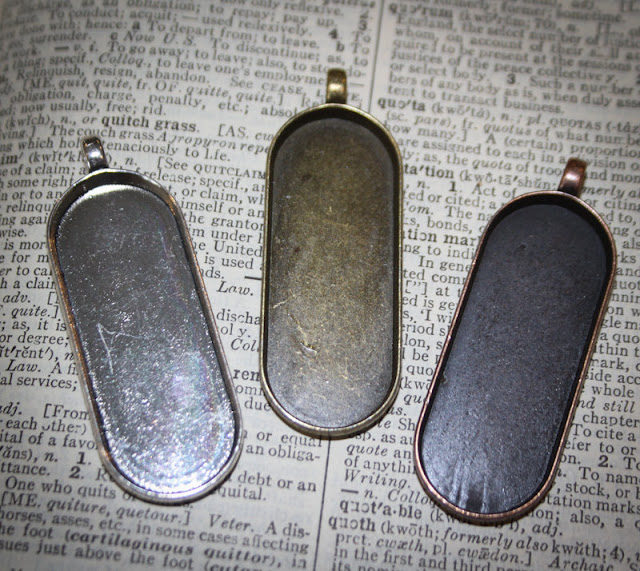
I found these great oval shaped bezels in my stash that really mimic the shape of the ancient cartouche, like you see in the image of the goddess. A cartouche is an oval with a horizontal line at one end, indicating that the text enclosed is a royal name. At one time only Pharaohs wore a cartouche as jewelry, being careful not to lose it, as they believed that whoever possessed the name had control over the person. The oval around the hieroglyphs was there to protect them from evil
spirits in life and after death. This came to symbolize good luck and protection from evil. To an
Egyptian, if you had your name recorded somewhere you did not disappear after death, so you will see these frequently inscribed on sarcophagi or on tomb walls.
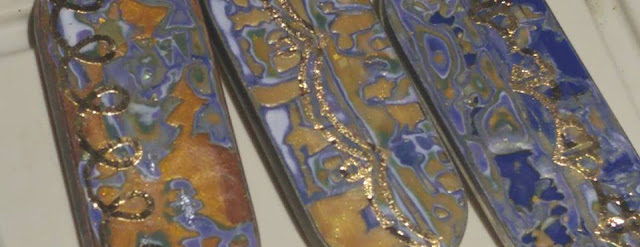
I used straight colors from the stack for the base – each one slightly different. Then I layered thin slices of the mokume gane on top, letting some of the base color show through. Since Nefertari was known as the “king’s great wife” I figured there should be touches of gold. Each pendant got a different gold touch with the application of… get ready for this… a temporary tattoo! Unfortunately, even after baking, the tattoos were a bit tacky (they are temporary, after all!). So I decided to layer a coat of UV resin on top to seal the crumbles and gold applique. A bonus of resin is that it amplifies the beauty of whatever is underneath. Plus it is rock hard!
My tribute to the “mistress of charm, sweetness and love” is what I call Nefertari’s Tomb, and they are available in my webstore. I like to think that the Queen would approve!
Would you like to win one of your very own? I would love to make one just for you! So I am giving away a $25 gift certificate to my webstore www.tesoritrovati.com (which equals the price of the pendant… or whatever else you might like 😉 for an answer to this question:
What new technique would you like to learn
AND
what action are you taking to make that happen?
Share links if you have them!

